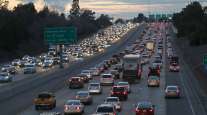Studies Show Auto Driver Often at Fault in Truck-Involved Crashes, ATA Reports
This story appears in the Feb. 18 print edition of Transport Topics.
As many as three of every four crashes involving cars and heavy trucks are caused by automobile “driver factors” such as speeding or failure to stay in a lane, according to a report released last week by American Trucking Associations.
ATA said the report was aimed at highlighting that in most car-truck accidents, the truck driver could not have prevented the crash. In addition, the federation wants to draw attention to the fact that many studies were based on information contained in police accident reports.
The federation’s report comes after an accident reconstruction expert told members of a Federal Motor Carrier Safety Administration advisory panel examining the agency’s Compliance, Safety, Accountability safety rating program that police accident reports are not always reliable as a sole source to determine fault.
However, David Osiecki, ATA’s senior vice president of policy and regulatory affairs, said the federation’s report showed that police accident reports often are used properly to arrive at fault conclusions.
“So police accident re-ports have been used for years and years to look at driver factors and relative contributions,” Osiecki told Transport Topics. “Anybody who’s suggesting that police accident reports can’t be used to get to that end doesn’t really understand the history of relative fault, relative contribution research.”
ATA’s report included studies from the University of Michigan Transportation Research Institute, the National Highway Traffic Safety Administration, AAA and the FMCSA.
Data from a Michigan study showed that in fatal car-truck crashes, cars were the encroaching vehicle in 89% of head-on crashes, 88% of opposite-direction sideswipes, 80% of rear-end crashes and 72% of same-direction sideswipes — all indicators that the car was at fault.
ATA has urged FMCSA to use police accident reports as a way to assign fault for CSA data purposes.
“It is imperative that FMCSA institute a fair process to address the question of crash accountability in its Compliance, Safety, Accountability monitoring system,” ATA President Bill Graves said.
Osiecki said that police accident reports aren’t completely accurate and are not always completely filled out, but they can be used to make determinations of who initiated a crash and who was the primary contributor in many cases.
“While not perfect, they’re pretty good,” Osiecki added. “We can’t let perfect be the enemy of the good.”
FMCSA spokesman Duane De-Bruyne had no immediate comment on the ATA report, but said the agency is working with its partners on a crash-weighting research plan to better assess carrier roles in crashes.
FMCSA expects to complete its study this summer, which will include research into determining whether police accident reports from across the nation “provide sufficient, consistent and reliable information to support crash weighting determinations,” De-Bruyne said.
DeBruyne said the study also will assess whether a carrier’s role in a crash is a stronger predictor of future crash risk than crash involvement alone, and, if so, how crash weighting should be implemented in the agency’s safety ratings system.
In addition, the study will evaluate how FMCSA could use additional data in the determination process to allow for public input, DeBruyne said.
Henry Jasny, senior counsel for the Advocates for Highway and Auto Safety, said the ATA report was “déjà vu all over again.”
“It was all old stuff,” Jasny said. “Partly it’s the old blame game about who was responsible and who’s at fault. But you can’t use those studies for that purpose — the data sets that they were using in nearly all those studies.”



